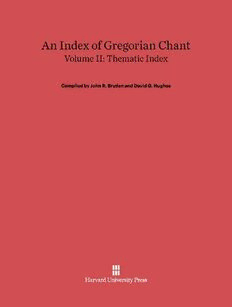Table Of ContentAn Index of Gregorian Chant, Volume II
An Index of Gregorian Chant
Volume II: Thematic Index
Compiled by John R. Bryden and
David G. Hughes
Harvard University Press, Cambridge, Massachusetts, 1969
© Copyright 1969 by the President and Fellows of Harvard College
All rights reserved
Distributed in Great Britain by Oxford University Press, London
Library of Congress Catalog Card Number 71-91626
SBN 674-44875-8
Printed in the United States pf America
INTRODUCTION TO VOLUME II
The second volume of this Index contains largely the same information, and follows the same
rules as the first. For full particulars, the user is referred to the general introduction, Volume I,
pp. vi-xv. The following paragraphs deal with those matters in which Volume II differs from Volume I.
1. Content. Volume II contains all the entries of Volume I except those that for any reason
appeared there without melodic incipit.
2. Order. The order of entries in Volume II is determined by the eight figures of the melodic
incipit in algebraic sequence (i.e. -5, -3¡ -2, -1, 0, 1, 2, etc.). Kntries having the same
melodic code are arranged in alphabetical order of their texts. If the texts are also the same, then
the order is by the textual incipit of the main chant (if the entries are for verses), or the page
number or item number in the first source cited (e.g., of two Kyrie with identical melodic incipit,
MEL #184 would precede MEL #185).
3. Arrangement of the entries. In the first column there appears the starting pitch of the
chant. As in Volume I, this is for information only, and has no effect on the filing order. There
follows the eight-number melodic code. Then the final is given, except in the case of verses. The
text incipit appears next, followed by the sources, the category, and the mode (the last also omitted
for verses).
Discrepancies between the two volumes. In general, the entries in Volume II duplicate
exactly those in Volume I, even at the cost of occasional minor incongruities. Thus, for exançle,
the entries for an Alleluia and its verse, separated by hundreds of pages in Volume I, are here often
brought directly together, making it evident that the text incipit has been carried out to different
lengths in the two entries (e.g. "Alleluia: benedicamus patrem . . • laudemus," followed at once by
its verse, "Benedicamus patrem et filium cum ... laudemus"). This is natural, since the amount of
text used was determined by the need to achieve clarity in the alphabetical arrangement of Volume I.
There seemed to be no need to impose an artificial uniformity on such cases in Volume II--indeed,
there was some risk that to do so would invite error or obscurity.
A somewhat different problem is presented by the indication of mode. It seems at least odd
to find a group of entries, all with the same melodic incipit and final, of which some are assigned
to mode 2 and others to mode 1. In fact, however, identical incipits do not by any means guarantee
that the entire melodies are the same: difference in modal assignment may merely be the result of
different melodic continuations. Even when the melodies are substantially the same, the sources may
unequivocally disagree and assign one to the authentic and another to the piagai form. Only in the
case of the hymns from ST—where the modal designations are the compilers' own—has it been thought
occasionally desirable to impose uniformity, if only for appearance's sake. The few changes thus
made have all been from authentic to piagai of the same maneria, or the reverse, and they have not
been carried back into Volume I.
5. Appearance of textual variants. The re-ordering of the cards for Volume II brought to
light a number of cases of variant text-beginnings that conceal the identity of apparently different
chants. Thus, for exemple, Huic dum eremum turns out to be substantially the same, in both text and
music, as Qui dum eremum—an identity that passed unperceived so long as the two entries were many
pages apart in Volume I, but became evident when the melodic filing of Volume II brought them to suc-
cessive pages. In order to make use of such disclosures, however, to enlarge the number of cross-
references in Volume I, the compilers would have needed either to produce a duplicate set of cards,
so that both orders could be consulted at once, or to effect very extensive revisions in the final
typescript of the first volume. Neither of these was financially possible.
-ν-
Sigla Used for the Sources
(for full titles, see Vol. I, pp. xiii-xv)
AM Antiphonale monasticum
AR Antlphonale Romanum (or Liber antiphonarius)
BOS Bosse, Untersuchung . . · Gloria
GB Graduel de Benevent (Pal. mus. XV)
GR Graduale Romanum (or Liber gradualis)
GS Graduelle Sarisburiense
LA Antiphonaire monastique ... de Lucques (Pal. mus. IX)
LR Liber responsorialis
LU Liber usualis
MEL Melnicki, Das einstimmige Kyrie
OHS Officium hebdomadae sanctae
OTT Ott, Qffertoriale
PM Processionale monasticum
SCH Schildbach, Das einstimmige Agnus Dei
ST Stäblein, Die Hymnen
SYG Graduel de Saint-Yrieix (Pal. mus. XIII)
THAN Thannabaur, Das einstimmige Sanctus
VP Variae preces
WA Antiphonaire ... de Worcester (Pal. mus. XII)
Abbreviations for Categories of Chant
al Alleluia
alv Alleluia verse
an antiphon
anv antiphon verse
CO Communion
cov Communion verse
Gradual
gr
grv Gradual verse
hymn
hy
int Introit
intv Introit verse
inv invitatory
of Offertory
ofv Offertory verse
re great responsory
rev verse of great responsory
sr short responsory
tr Tract
trv verse of Tract
Other Abbreviations
ine illeg incipit (either textual or musical) illegible
ir tonus irregularis
nm no music
sup supplement
tp tonus peregrinus
var variant
AN I N D EX OF G R E G O R I AN CHANT
THEMATIC INDEX

